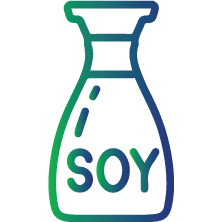
Food Intolerance Test
About Food Intolerance Test
A food intolerance test is used to determine whether you have any intolerance to specific types of food. Food intolerance occurs when the digestive system shows a negative reaction to certain foods. If someone is sensitive to certain foods, this can be determined with a food intolerance test.
Symptoms of food intolerance are closely related to food-specific antibodies (IgG) produced by the immune system. Food intolerances usually cause unpleasant symptoms and can lead to chronic illness. However, unlike food allergies, food intolerances are not life threatening.
The incidence of food intolerance is higher in the general population compared to the incidence of food allergy. The body's immune system reacts strongly to unfavourable foods, resulting in the production of antibodies that affect different parts of the body, causing symptoms of food intolerance.
Therefore, taking a food sensitivity test will give you a comprehensive list of foods to avoid preventing a bad reaction.
Symptoms of food intolerance
Symptoms of food intolerance usually occur within 3 days of eating the unsuitable food and may last for several weeks. It may be difficult to identify which foods are causing symptoms, so food intolerance testing is useful for providing guidance and assessing the degree of intolerance. Food intolerance symptoms include

Respiratory issues like rhinitis, sinusitis, asthma etc

Gastrointestinal issues like vomiting, bloating, nausea, constipation, diarrhea etc.

Skin issues like urticaria, atopic dermatitis eczema, itching, rashes etc

Musculoskeletal issues like joint pains, arthritis, body ache, weakness etc

Central nervous system issues like headache, mood changes, depression, anxiety etc
Causes of food intolerance
1
-
Absence of an enzyme that is required to fully digest a food, like having lactose enzyme deficiency causes lactose intolerance
2
-
Having irritable bowel syndrome, this is a chronic condition that can cause constipation, cramping, and diarrhea
3
-
Sensitivity to food additives, for example sulfites that are used to preserve dried fruit, canned products and wine may cause asthma attacks in sensitive people
5
-
Having celiac disease which is a chronic digestive condition that is triggered by eating gluten, a protein found in wheat and other grains
4
-
Recurring stress or psychological factors may sometimes cause aversion to food
Types of food you can have intolerance too
You can have an intolerance to any type of food including

Eggs

Fish

Milk

Peanuts

Shellfish

Soy

Tree nuts

Wheat
Test preparation
No special preparation is required
How is food intolerance diagnosed?
Hydrogen breath test: You need to drink a liquid containing lactose for this test. Then you will blow into a balloon-like container every half hour for a few hours. In people with lactose intolerance, undigested lactose causes high levels of hydrogen in their breath. Symptoms like vomiting, diarrhea may also occur after drinking a lactose solution. This test will be used detect lactose intolerance condition.
Antibody type IgG test: Food intolerance testing differs from food allergy testing. Food intolerance tests measure immunoglobulin G (IgG) and food intolerances are not life-threatening. Whereas food allergy tests measure immunoglobulin E (IgE) and food allergies may cause severe symptoms, it can also be life threatening. Our body produces IgG antibodies in response to a specific food when we might be intolerant or sensitive to it. This test measures these antibody levels for different food varieties to determine what food groups causes the intolerance.
Elimination diet: You will be advised to remove certain foods from your diet for a period of two to six weeks. If there are no food intolerance symptoms during this time and symptoms return when you consume certain foods again, it may indicate a food intolerance condition.
Interpretation of results
|
Parameters (age group) |
Normal IgG range for different age groups |
|
0-1 years |
231-1411 mg/dL |
|
1-3 years |
453-916 mg/dL |
|
4-6 years |
504-1464 mg/dL |
|
7-9 years |
572-1474 mg/dL |
|
10-11 years |
698-1560 mg/dL |
|
12-13 years |
759-1549 mg/dL |
|
14-15 years |
716-1711 mg/dL |
|
16-19 years |
549-1584 mg/dL |
|
19 years |
700-1600 mg/dL |
Deviation from normal levels indicates the following:
· High IgG level can be caused due to any infection in the body or reaction from certain foods.
· Low IgG level may be due to loss of protein in the body caused by the diseases like diabetes.
· If elevated level of IgG antibody is detected, then need to eliminate the causative food from diet for at least 3 months.
· If moderate level of IgG antibody is detected, then need to reduce the causative food from diet for at least 3 months.
· If normal level of IgG antibody is detected, then food can be eaten without any restrictions.
FAQs
What happens during food intolerance antibody testing?
A blood sample is collected from a vein in your arm using a small needle. Usually, this process does not take more than 5 minutes
What is the turnaround time (TAT) for the IgG based food intolerance blood test?
Test results of an IgG based blood test are usually available after 3-5 working days, although it could take longer at times
What are the risks associated with an IgG based food intolerance blood test?
This test involves negligible risk. There might be slight soreness or tenderness around the site where the blood is drawn. Rarely, the site can become infected
When should I go for a food intolerance test?
It is recommended to take food intolerance test when you notice any specific symptoms/ reactions after eating a certain type of food
How many varieties of food will be tested in the food intolerance profile?
Usually a food intolerance panel will test for 200 plus food varieties

